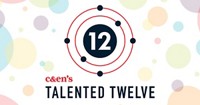Advertisement
Grab your lab coat. Let's get started
Welcome!
Welcome!
Create an account below to get 6 C&EN articles per month, receive newsletters and more - all free.
It seems this is your first time logging in online. Please enter the following information to continue.
As an ACS member you automatically get access to this site. All we need is few more details to create your reading experience.
Not you? Sign in with a different account.
Not you? Sign in with a different account.
ERROR 1
ERROR 1
ERROR 2
ERROR 2
ERROR 2
ERROR 2
ERROR 2
Password and Confirm password must match.
If you have an ACS member number, please enter it here so we can link this account to your membership. (optional)
ERROR 2
ACS values your privacy. By submitting your information, you are gaining access to C&EN and subscribing to our weekly newsletter. We use the information you provide to make your reading experience better, and we will never sell your data to third party members.
People
And The Winner Is …
by A. Maureen Rouhi
January 21, 2013
| A version of this story appeared in
Volume 91, Issue 3
Awards season has begun in Hollywood, with the announcements of Oscar nominees early this month and of Golden Globe Award winners just two weeks ago. Whether in the form of a Hollywood trophy, an Olympic medal, or an award from the American Chemical Society, peer recognition brings many benefits.
Recognition of achievement can bring fame and fortune. But perhaps most important for science, honors and awards enable the continuation of work that helps us understand the world and solve myriad human problems.
Unlike Hollywood types, scientists in general seem averse to tooting their own horns. I know chemists who have refused to talk to C&EN about their work because they think doing so could be deemed unseemly by their peers. Yet telling the world why one’s research is useful, and getting well-deserved recognition, is critical to ensuring that the work of science continues. Recognition is a signal that the work is useful for society. For this reason, I commend the ACS National Awards Program, the sponsors of individual awards, the nominators, and the selectors. By focusing attention on individuals who have made outstanding contributions to chemistry and related fields, they do an immense public service.
The ACS National Awards Program can be traced back to April 1916, when the ACS Council requested the appointment of a committee to plan and carry out a memorial to Joseph Priestley, according to Frank Walworth, assistant to the ACS secretary and president. Because World War I intervened, the council’s recommendation to establish a Priestley Medal could not be acted upon until 1922. The first award was given in September 1923. According to a story in Industrial & Engineering Chemistry News Edition (Sept. 20, 1923, page 3), Ira Remsen, president emeritus of Johns Hopkins University, was selected for giving “the world a translation of Woehler’s ‘Organic Chemistry’ which greatly aided the rising generation of chemists,” among other achievements.
ACS currently has 65 national awards, according to Felicia Dixon, manager of the ACS National Awards Office. They recognize individuals and teams for reasons such as exceptional volunteer service and outstanding accomplishments in the classic chemistry disciplines. Most carry a modest cash prize plus travel expenses to the awards ceremony.
ACS fetes its national awardees every year at the spring national meeting. Those familiar with the event fondly refer to it as the “Academy Awards for Chemists.” It’s an evening when the spotlight is on high-achieving chemists clad in tuxedos or evening gowns. Glamour and smarts make a winning combination.
In advance of the awards night, C&EN celebrates the awardees through short profiles published in the first eight or nine issues of the year. It’s an all-staff effort, a labor of love, to interview winners and describe their lives in these vignettes, says C&EN Assistant Managing Editor for ACS News & Special Features Sophie Rovner. She manages this project, which begins in October and gets completed in February or early March. Despite the sometimes frustrating logistics, she says, the project is one of her favorites: “I come away just being impressed with the winners’ achievements, with the adversity that several have overcome, and with the fact that so many of them grew up with chemistry sets.”
In this issue is the third batch of short profiles (see page 33). If you haven’t formed the habit of reading these vignettes, begin now. Be inspired by awardees’ creativity, ingenuity, and determination in solving problems and advancing the science. Imagine yourself basking in the same glow of achievement.
In addition, C&EN devotes a cover feature each spring to the recipient of the Priestley Medal, ACS’s highest honor. This year, C&EN’s April 8 issue will have a profile and the award address of 2013 Priestley Medalist Peter J. Stang, Distinguished Professor of Chemistry at the University of Utah and editor-in-chief of the Journal of the American Chemical Society.
Views expressed on this page are those of the author and not necessarily those of ACS.



Join the conversation
Contact the reporter
Submit a Letter to the Editor for publication
Engage with us on Twitter